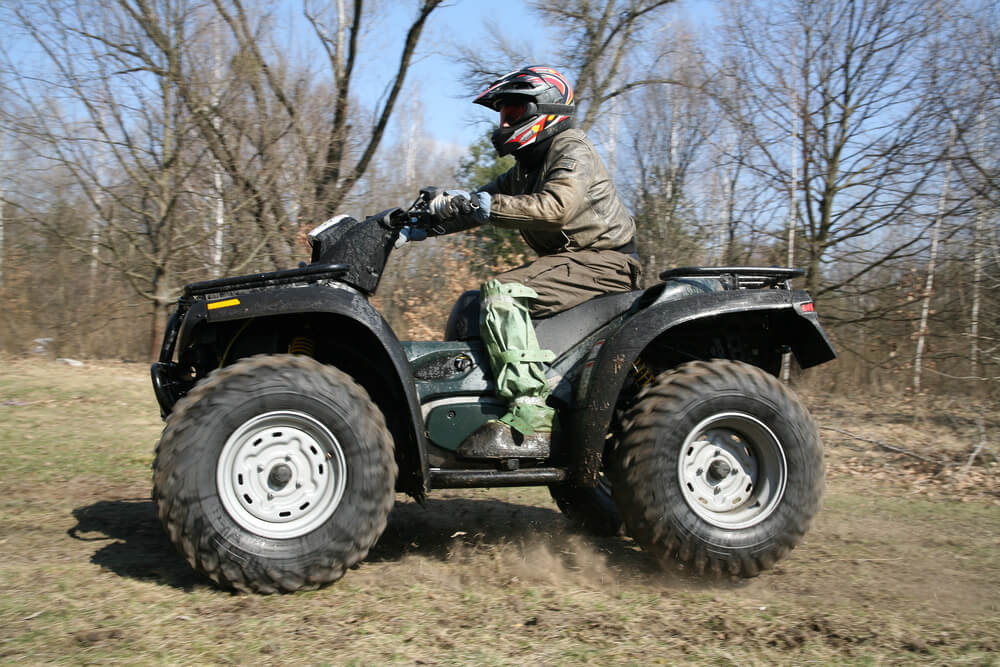This blog post delves into the significant yet often overlooked role of All-Terrain Vehicles (ATVs) in local economies. It explores how these off-road vehicles contribute to economic growth, drive tourism, and create employment opportunities in numerous regions. The post also examines the downsides, including environmental issues and safety concerns.
The Rise of ATV Popularity: A Growing Trend?
In recent years, the popularity of all-terrain vehicles (ATVs) has been on the rise. These powerful machines, designed for off-road adventures, have captured the attention of outdoor enthusiasts and thrill-seekers alike.
With their ability to traverse rugged terrains and explore remote locations, ATVs have become a go-to choice for those seeking adrenaline-pumping experiences. But what has fueled this surge in popularity? Is it just a passing trend or a long-lasting phenomenon?
One factor contributing to the growing popularity of ATVs is the increasing accessibility of off-road trails and recreational areas. Many regions have recognized the economic potential of promoting ATV tourism and have invested in developing trails and infrastructure to cater to this demand.
This has made it easier for ATV enthusiasts to find suitable places to ride and explore, further fueling their interest in these powerful machines.
Additionally, the rise of social media and online communities has played a significant role in popularizing ATVs. Through platforms like Instagram and YouTube, individuals can share their thrilling off-road experiences and connect with like-minded enthusiasts. This has created a sense of community and camaraderie among ATV riders, fostering a positive image and encouraging more people to join in on the fun.
Furthermore, the versatility of ATVs has also contributed to their growing popularity. These vehicles can be used for various purposes, ranging from recreational activities to practical tasks such as farming or hunting. Their ability to navigate challenging terrains and carry heavy loads makes them a valuable tool in many industries, further expanding their appeal.
Impact of ATVs on Local Economies:
| Region | Economic Impact | Employment Opportunities | Concerns |
|---|---|---|---|
| Alaska | Increased tourism and hotel stays | ATV rental and tour guide services | Environmental impact and safety |
| Arizona | Increased tourism and retail sales | ATV parts and repair services | Safety and noise pollution |
| California | Increased tourism and local spending | ATV guides and rental services | Environmental protection and safety |
| Colorado | Increased tourism and recreation opportunities | ATV maintenance and repair services | Safety and noise pollution |
ATVs and Local Economies: An Unexpected Connection
When we think of local economies, industries like manufacturing, agriculture, and tourism often come to mind. However, one industry that may not immediately come to mind is the ATV industry. Yet, the impact of ATVs on local economies should not be underestimated. These powerful off-road vehicles have the potential to make a significant contribution to the economic growth of communities.

First and foremost, the ATV industry itself plays a vital role in local economies. From manufacturing to sales and distribution, the ATV industry creates jobs and generates revenue. Manufacturers employ workers to assemble ATVs, while dealerships provide employment opportunities for salespeople and mechanics. Additionally, the demand for ATV accessories and aftermarket parts creates a thriving market for small businesses, further stimulating local economies.
Moreover, the presence of ATVs can attract tourists to an area, thereby boosting local businesses. Many ATV enthusiasts are willing to travel long distances to explore new trails and enjoy off-road adventures.
This influx of visitors translates into increased tourism revenue for local accommodations, restaurants, and recreational businesses. Hotels and campgrounds may experience higher occupancy rates, and restaurants may see an uptick in customers seeking a post-ride meal. Local shops that cater to the needs of ATV riders, such as gear and equipment stores, can also benefit from the increased tourism.
Furthermore, the economic impact of ATVs extends beyond the immediate industry and tourism. The increase in ATV-related activities often leads to the growth of supporting industries.
For example, ATV repair shops, rental services, and guided tour companies may emerge to cater to the needs of ATV enthusiasts. These businesses not only provide additional employment opportunities but also contribute to the local economy through the purchase of supplies and services.
“If you build it, they will come” – The Impact of ATV Trails on Tourism.
ATV trails, when properly developed and maintained, have a remarkable impact on tourism in local economies. These designated trails provide a safe and enjoyable environment for ATV enthusiasts to explore and experience the thrill of off-roading. The availability of well-designed ATV trails attracts riders from far and wide, resulting in a significant boost to tourism in the area.
- 1. The Magnet for ATV Enthusiasts:
ATV trails act as a magnet, drawing in riders who are eager to explore new and challenging terrains. These trails provide a sense of adventure and allow riders to experience the natural beauty of the surrounding landscapes. As word spreads about well-maintained trails, more and more ATV enthusiasts are likely to visit, contributing to the growth of tourism in the region. - 2. Spillover Effect on Local Businesses:
The presence of ATV trails creates a spillover effect on local businesses. Riders who travel to access these trails need accommodation, food, and other services during their stay. Local hotels, bed and breakfasts, and campgrounds benefit from the increased demand for lodging. Restaurants and cafes see a rise in customers looking for fueling stops before or after their ATV adventures. Moreover, other recreational businesses such as fishing charters, hiking tour operators, and outdoor gear stores can also experience increased patronage due to the influx of ATV tourists. - 3. Economic Development in Rural Areas:
ATV trails often traverse through rural areas that may have limited economic opportunities. The development of these trails can inject new life into these communities, driving economic development and diversification. Local businesses, previously reliant on traditional industries, can now tap into the growing ATV tourism market. This can lead to the creation of new jobs and increased income, providing a much-needed boost to the local economy.

Job Creation: A Direct Consequence of ATV Industry?
The ATV industry has a direct impact on job creation in local economies. This thriving industry requires a skilled workforce to design, manufacture, and distribute ATVs. Additionally, the maintenance and repair of ATVs also create employment opportunities.
- 1. Manufacturing Jobs:
The production of ATVs requires a diverse range of skills, from engineering and design to assembly and quality control. ATV manufacturers employ a significant number of workers, contributing to job creation in the manufacturing sector. These jobs not only provide employment but also offer career advancement opportunities for individuals with technical expertise. - 2. Dealerships and Retailers:
The sale of ATVs through dealerships and retailers creates job opportunities in the sales and customer service sectors. Dealerships require sales representatives, technicians, and administrative staff to handle customer inquiries, facilitate sales, and provide after-sales support. Retailers specializing in ATV accessories and gear also benefit from the demand generated by the ATV industry, further contributing to job creation. - 3. ATV Repair and Maintenance:
ATVs require regular maintenance and occasional repairs, creating a demand for skilled technicians. Independent ATV repair shops, as well as service departments within dealerships, provide employment opportunities for mechanics and technicians specializing in ATV maintenance and repair. These jobs not only support the ATV industry but also provide a valuable service to ATV owners, ensuring the longevity and safe operation of their vehicles.The job creation potential of the ATV industry extends beyond direct employment. The growth of the industry stimulates demand in related sectors, such as tourism, hospitality, and retail. As ATV enthusiasts visit various destinations to enjoy their off-road adventures, local businesses catering to their needs experience increased demand and subsequently create job opportunities.

Is ATV Manufacturing an Unsung Economic Hero?
ATV manufacturing often goes unnoticed as a significant economic contributor, but its impact cannot be underestimated. The manufacturing of ATVs creates a ripple effect throughout the supply chain, benefiting numerous industries and supporting local economies.
- 1. Supply Chain Support:
ATV manufacturing relies on a complex network of suppliers and vendors. From raw materials like steel and plastic to specialized components like engines and suspension systems, the production of ATVs requires a steady supply of inputs. This creates business opportunities for suppliers, fostering economic growth in the manufacturing sector. - 2. Ancillary Industries:
ATV manufacturing also fuels the growth of ancillary industries. Companies specializing in the production of ATV accessories, aftermarket parts, and safety gear thrive due to the demand generated by the manufacturing sector. These businesses provide additional employment opportunities and contribute to the overall economic health of the local community. - 3. Research and Development:
Innovation is key to the success of the ATV industry. Manufacturers invest in research and development to improve the performance, safety, and environmental sustainability of ATVs. This commitment to innovation supports jobs in engineering, design, and testing, while also driving technological advancements that can have broader applications beyond the ATV industry. - 4. Export Opportunities:
ATV manufacturing can also serve as an economic driver through export opportunities. Well-established manufacturers often export their products to international markets, bringing in revenue and positively impacting the local economy. The success of ATV manufacturing can enhance a region’s reputation as a hub for manufacturing excellence, attracting further investment and creating additional jobs. - 5. Economic Multiplier Effect:
The economic impact of ATV manufacturing extends beyond direct employment and supply chain support. The jobs created by the industry generate income, which in turn stimulates consumer spending in local businesses. This multiplier effect further boosts the local economy, supporting various sectors such as retail, hospitality, and services.
Riding into the Sunset: The Role of ATVs in Recreational Activities
ATVs have become a popular choice for outdoor enthusiasts seeking thrilling recreational activities. The versatility and off-road capabilities of ATVs have opened up a world of adventure, attracting individuals and families alike. Whether it’s exploring rugged terrains, conquering mud pits, or cruising through scenic trails, ATVs offer a unique and exhilarating experience for outdoor enthusiasts.
- 1. Adventure and Exploration:
ATVs provide an opportunity for adventure and exploration like no other. Riders can venture into remote areas, discovering hidden gems and breathtaking landscapes that are inaccessible by traditional vehicles. From dense forests to mountainous regions, ATVs allow riders to immerse themselves in nature, taking in the beauty of their surroundings while enjoying an adrenaline-pumping ride. - 2. Community and Social Engagement:
ATV riding has also fostered a sense of community among enthusiasts. ATV clubs and organizations have formed, bringing together like-minded individuals who share a passion for off-roading. These communities often organize group rides, events, and competitions, providing opportunities for social engagement and networking. This sense of camaraderie creates lasting friendships and strengthens the fabric of local communities. - 3. Family-Friendly Recreation:
ATV riding has evolved into a family-friendly recreational activity. Many ATV manufacturers offer models specifically designed for youth riders, ensuring that the whole family can participate in the adventure. Family-oriented ATV parks and trails have sprung up across the country, providing a safe and enjoyable environment for riders of all ages. These family outings not only create cherished memories but also contribute to local economies through increased tourism and spending on accommodations, dining, and other recreational activities.
The Hidden Economic Impact of ATV Repair and Maintenance
ATVs are powerful machines that require regular maintenance and occasional repairs to keep them in top condition. This need for maintenance and repair has given rise to a thriving industry that contributes significantly to the local economy. ATV repair and maintenance shops provide essential services to ATV owners, ensuring their vehicles are safe, reliable, and perform optimally.
One of the key economic impacts of the ATV repair and maintenance industry is job creation. These establishments employ skilled technicians and mechanics who specialize in servicing and repairing ATVs.
These professionals not only contribute to the local economy through their employment but also generate income through the services they provide. Additionally, the demand for ATV repair and maintenance creates opportunities for suppliers and manufacturers of ATV parts and accessories, further stimulating the local economy.
ATV repair and maintenance shops also have a multiplier effect on the economy. When riders bring their ATVs in for repairs or maintenance, they often spend money on other goods and services in the area. They may visit local restaurants, and shops, or even stay overnight in nearby accommodations. This increased consumer spending boosts local businesses and generates revenue for the community.
Moreover, ATV repair and maintenance shops can attract customers from outside the immediate area. Riders will travel to find reputable and experienced technicians who can service their ATVs effectively. This influx of customers from other regions or even neighboring states can bring tourism and additional income to the local economy.
Furthermore, the demand for ATV repair and maintenance services encourages entrepreneurship and small business growth. Entrepreneurs may start their own ATV repair and maintenance shops to capitalize on the increasing popularity of ATVs. This not only creates additional job opportunities but also fosters competition and innovation within the industry.
What About the Environment? The Dark Side of ATVs
ATVs have gained popularity due to their off-road capabilities and ability to navigate challenging terrains. However, this enthusiasm for ATV riding has raised concerns about the environmental impact of these vehicles. ATVs have been known to cause significant damage to ecosystems, especially in sensitive areas such as wetlands, forests, and fragile habitats. The powerful engines and aggressive tires of ATVs can destroy vegetation, erode soil, and disturb wildlife habitats. This destruction can have far-reaching consequences for local ecosystems and biodiversity.
Additionally, the noise and air pollution generated by ATVs can disrupt the natural tranquility of these areas, disturbing wildlife and negatively impacting the overall environmental balance.
The erosion caused by ATV use can lead to sedimentation in water bodies, degrading water quality and affecting aquatic life. ATVs are often used in recreational areas near rivers, lakes, and streams, increasing the risk of pollutants, such as oil and fuel, entering the waterways.
These pollutants can have harmful effects on aquatic ecosystems, including fish and other aquatic organisms. The disruption of vegetation and soil by ATVs can also contribute to increased soil erosion and sedimentation in water bodies, further degrading the quality of aquatic habitats.
Furthermore, the unauthorized use of ATVs in protected areas and off-limits zones can have severe consequences for sensitive ecosystems and endangered species. The uncontrolled access and reckless driving by some ATV riders can lead to habitat destruction, disturbance of nesting sites, and trampling of rare plants. This disturbance can disrupt the balance of these ecosystems and threaten the survival of vulnerable species.
Safety Concerns: Are We Paying a High Price for ATV-Driven Growth?
The increasing popularity of ATVs has raised serious safety concerns that cannot be ignored. While ATV riding can be an exhilarating and enjoyable activity, it also comes with inherent risks. One of the main concerns is the high rate of accidents and injuries associated with ATV use.
Data from various studies and reports show that ATV-related accidents lead to a significant number of emergency room visits and even fatalities. The powerful engines and speed capabilities of ATVs, combined with the lack of safety features such as seat belts and roll cages, make riders particularly vulnerable to accidents.
Moreover, the demographics of ATV riders also contribute to safety concerns. A significant number of ATV accidents involve young riders, including children and teenagers, who may not possess the necessary skills or experience to handle these vehicles safely. Additionally, the lack of proper training and education on ATV operation and safety precautions further increases the risk of accidents.
Environmental factors also play a role in ATV safety. Uneven terrains, unpredictable weather conditions, and unfamiliar trails can present challenges for even the most experienced riders. Off-road riding can expose riders to various hazards, such as rocks, tree stumps, and hidden obstacles, which can lead to accidents and injuries.
The economic costs associated with ATV accidents and injuries are another important consideration. The medical expenses, rehabilitation costs, and potential loss of productivity resulting from ATV-related injuries can place a significant burden on individuals, families, and healthcare systems. Additionally, the legal and insurance costs associated with ATV accidents can have repercussions on individuals and businesses alike.
The Tax Implications: How does ATV use Benefit Local Governments?
ATV use can have significant tax implications that benefit local governments in various ways. First and foremost, the sale of ATVs generates sales tax revenue for local governments. As the popularity of ATVs continues to rise, more and more individuals are purchasing these vehicles, resulting in increased sales tax revenue for the local economy. This revenue can be used to fund essential public services such as infrastructure development, education, and healthcare.
Additionally, the operation of ATVs requires the purchase of fuel, which is subject to fuel taxes. These taxes are typically earmarked for transportation-related projects, such as road maintenance and repairs.
With the increasing number of ATVs on the road and off-road trails, the demand for fuel also rises, resulting in higher fuel tax revenue for local governments. This revenue can be used to improve transportation infrastructure, ensuring safer and more accessible routes for ATV riders.
Furthermore, ATV registration fees contribute to local government revenues. Many jurisdictions require ATV owners to register their vehicles and pay an annual fee. These fees can serve as a source of revenue for local governments, which can be used to invest in ATV-specific infrastructure, such as designated trails, parking areas, and signage. This not only enhances the riding experience for ATV enthusiasts but also boosts tourism and economic activity in the region.
In addition to direct tax revenues, ATV use can indirectly benefit local governments through increased tourism and visitor spending. Many ATV riders travel to different areas to explore new trails and enjoy off-road adventures. This influx of visitors can have a positive economic impact on local businesses, including hotels, restaurants, gas stations, and retail stores. The resulting increase in sales tax revenue can further contribute to the economic growth and development of the local community.
ATVs and Real Estate: Is there a Link?
The connection between ATVs and real estate may not be immediately apparent, but there are indeed several ways in which these two industries intersect and influence each other.
- 1. Recreational Properties:
One of the most direct links between ATVs and real estate is the demand for recreational properties. ATV enthusiasts often seek out properties that offer easy access to trails and off-road riding opportunities. As a result, areas with a strong ATV culture and well-developed trail systems may experience increased demand for real estate. This can lead to rising property values and a boost in the local real estate market. - 2. Land Use and Development:
The presence of ATV trails and riding areas can also impact land use and development patterns. Developers and landowners may choose to incorporate ATV-friendly amenities into their projects, such as designated trails or private riding areas. This can make their properties more attractive to potential buyers or renters who enjoy ATV activities. On the other hand, local zoning regulations and land-use planning may also restrict ATV access in certain areas to protect sensitive ecosystems or maintain the tranquility of residential neighborhoods. - 3. Economic Impact on Housing Market:
The ATV industry, particularly in regions with thriving ATV tourism, can have a significant economic impact on the housing market. Increased visitor spending on ATV-related activities can stimulate job growth and income levels in the local economy. This, in turn, can lead to increased demand for housing, both for permanent residents and seasonal visitors. As the ATV industry grows, so does the need for housing options to accommodate riders and their families, leading to a potential boost in the real estate market.
The Ripple Effect: How ATVs Influence Local Businesses
ATVs have a ripple effect on local businesses that goes beyond just the ATV industry itself. When ATV enthusiasts flock to an area for riding opportunities, they bring with them a surge in economic activity that benefits a wide range of local businesses.
First and foremost, businesses directly related to the ATV industry, such as ATV dealerships, rental shops, and repair services, experience increased demand for their products and services. ATV riders require equipment, accessories, and maintenance, creating a steady stream of customers for these businesses. This, in turn, leads to job creation and an overall boost to the local economy.
But the impact doesn’t stop there. ATV enthusiasts also need places to eat, sleep, and refuel during their adventures. Local restaurants, hotels, and gas stations often see an increase in customers and revenue as a result of the influx of ATV riders. These businesses can capitalize on the opportunity by offering ATV-friendly amenities, such as secure parking, special menus, and accommodations tailored to the needs of riders.
Furthermore, the ATV industry can indirectly benefit other businesses in the area. Local retailers may see a surge in sales of outdoor gear, clothing, and accessories favored by ATV riders. Additionally, businesses that offer recreational activities, such as horseback riding, hiking, or fishing, may experience increased demand as ATV enthusiasts seek additional ways to enjoy their time in the area.
The ripple effect of ATVs on local businesses goes beyond immediate spending. The increased traffic and exposure generated by ATV tourism can also attract new businesses to the area. Entrepreneurs may recognize the potential for growth and choose to open new shops, restaurants, or accommodations to cater to the growing ATV market. This can lead to long-term economic development and diversification in the local business landscape.
Striking a Balance: Can We Harness ATV Economic Benefits Minus the Downsides?
The economic benefits brought about by ATVs are undeniable, but it is crucial to address the downsides associated with their use. One of the primary concerns is the environmental impact caused by off-road ATV riding. The destruction of natural habitats, soil erosion, and pollution are significant issues that need to be addressed. Stricter regulations and enforcement of responsible riding practices can help mitigate these negative effects and ensure the sustainability of the local environment.
In addition to environmental concerns, safety is another area that requires attention. ATV accidents can result in serious injuries or even fatalities, which not only affects the individuals involved but also impacts the local economy.
Medical expenses, legal proceedings, and a decrease in tourism due to safety concerns can all have a detrimental effect on the overall economic health of the community. Implementing safety education programs, enforcing age restrictions, and promoting responsible riding practices can help reduce the number of accidents and create a safer environment for both riders and other individuals in the area.
Furthermore, striking a balance between economic benefits and community harmony is essential. Some communities may experience noise pollution, traffic congestion, and conflicts between riders and non-riders. Engaging in open dialogues and establishing guidelines that address these concerns can help foster positive relationships between ATV riders and the local community. It is essential to consider the needs and concerns of all stakeholders to ensure a harmonious coexistence.
Finally, sustainable economic development should be a key consideration. Diversifying the local economy and not solely relying on the ATV industry can help mitigate the risks associated with overdependence. Investing in other sectors, such as tourism, agriculture, or technology, can create a more resilient and balanced economy. This diversification can also help mitigate the potential negative impacts of economic downturns within the ATV industry.
In conclusion, while ATVs undoubtedly have some negative environmental and safety impacts, their contribution to local economies cannot be overlooked. They stimulate economic growth, generate jobs, and promote tourism.
It is crucial for stakeholders to strike a balance between economic benefits and potential drawbacks, ensuring that the use of ATVs is regulated in a manner that maximizes their positive economic impact while minimizing any negative effects.














